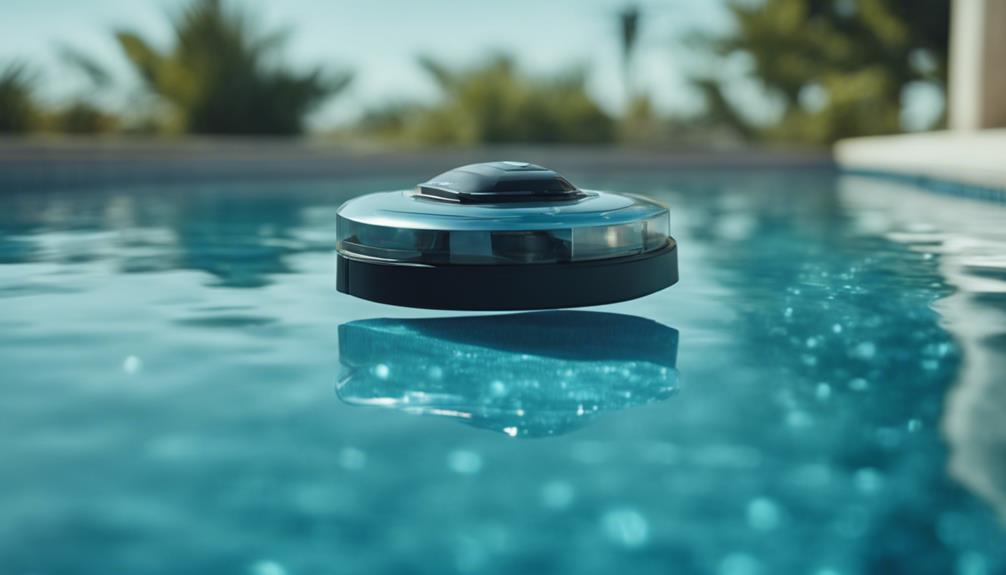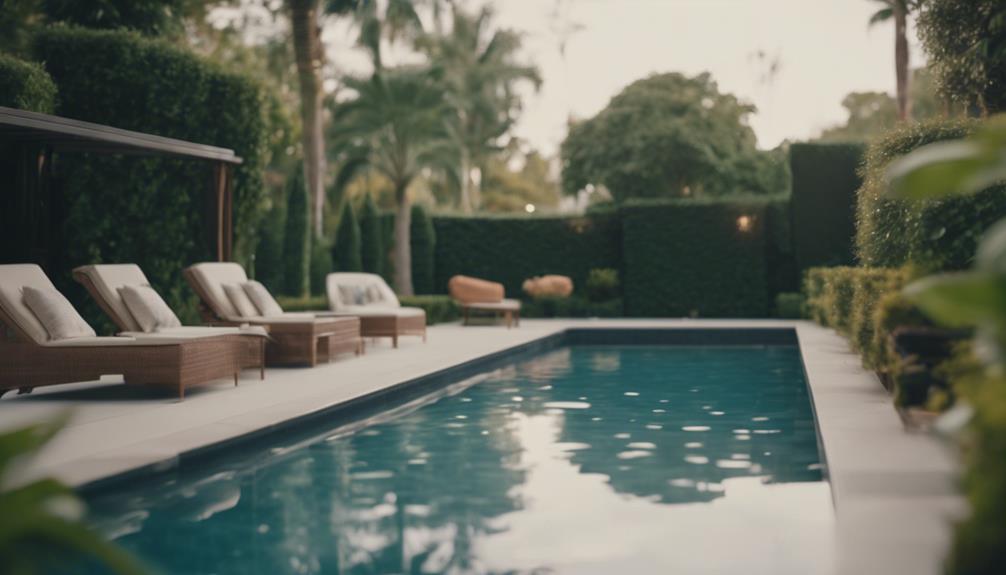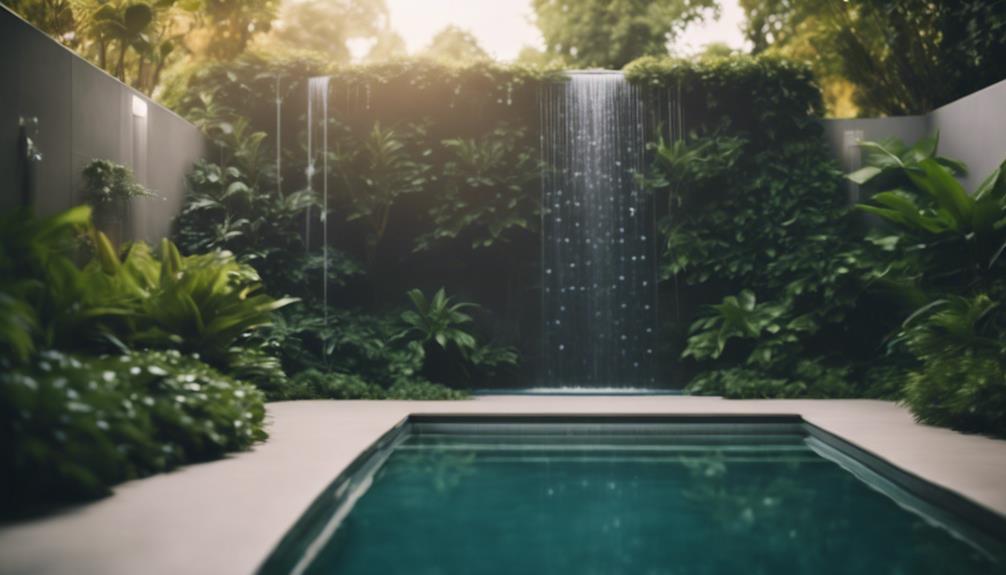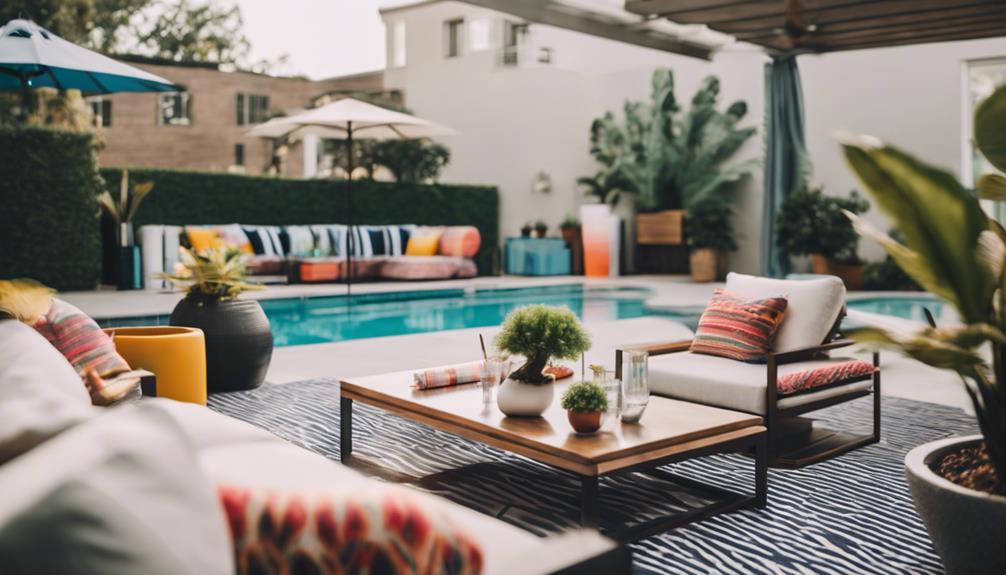Enhance the beauty and functionality of your swimming pool area with these retaining wall ideas. Explore options such as natural stone, wood, concrete blocks, or gabion walls for a diverse and stylish look. Add elegant tile patterns or artistic designs to further enhance the beauty of your pool area. It is important to use durable materials and proper construction techniques to ensure longevity. Regular maintenance, including drainage upkeep and inspections, is essential. Consider integrating LED lighting and planters for a stylish touch. Proper planning, including evaluating the area, obtaining permits, and selecting suitable materials, is key. These ideas will not only elevate the aesthetic appeal but also enhance the practicality of your pool space.
Key Takeaways
- Incorporate natural stone or artistic tile patterns for aesthetic appeal.
- Use durable materials like concrete blocks for longevity.
- Ensure proper drainage to prevent wall failure.
- Integrate LED lighting and planters for functional beauty.
- Follow correct construction techniques for a visually appealing result.
Materials for Pool Retaining Walls
When choosing materials for your swimming pool retaining walls, consider options like natural stone, wood, concrete blocks, and gabion walls for varying aesthetics and functionalities.
Natural stone walls offer a rustic and durable choice that seamlessly blends with pool surroundings, providing a range of color and texture options.
Wooden retaining walls create a warm and inviting atmosphere, customizable to fit any design style while adding a natural element to the poolside.
Concrete block walls, on the other hand, provide strong and modern construction, resistant to weather and wear, with versatile design possibilities for a contemporary look.
If you're looking for a unique and eye-catching design, gabion walls allow for natural drainage and can be filled with various materials to achieve a customized textured appearance.
Each of these materials offers different aesthetics and functional benefits for pool areas, so choose the one that best suits your style preferences and practical needs.
Design Elements for Enhanced Beauty
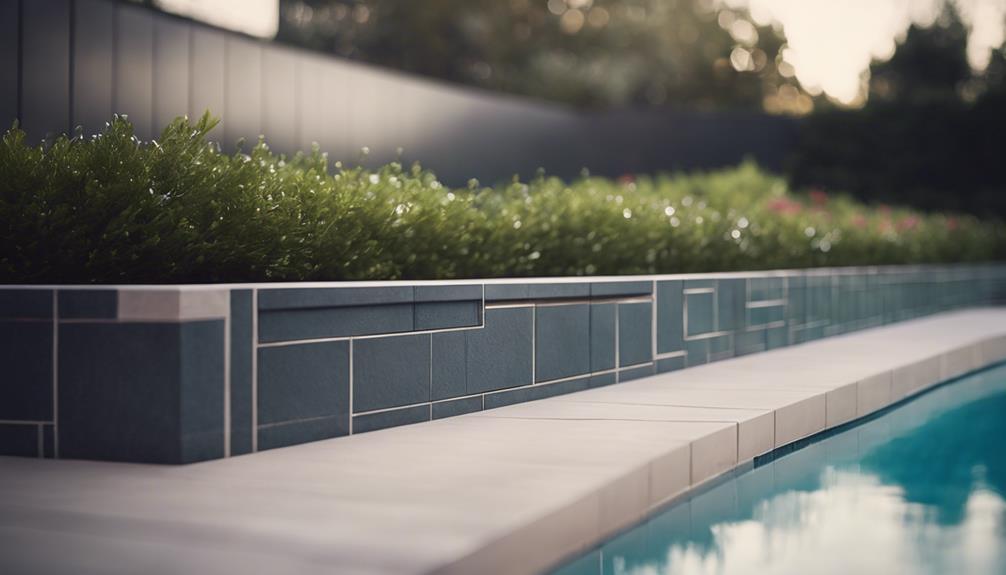
Enhancing the beauty of your swimming pool area can be achieved through incorporating natural stone elegance and artistic tile patterns into your retaining walls. These design elements not only add visual interest but also bring a touch of sophistication to your outdoor space.
Natural Stone Elegance
Crafted from rugged fieldstone or sleek bluestone, natural stone retaining walls offer a timeless elegance that seamlessly integrates with your pool surroundings, enhancing the overall beauty of your outdoor space. These walls not only provide structural support but also contribute to the visual appeal of your swimming pool area. The varied textures and colors of natural stone options allow for a customized look that complements your landscape design.
To illustrate the beauty and charm that natural stone retaining walls can bring to your outdoor space, consider the following table showcasing different types of natural stones commonly used in retaining wall design:
| Stone Type | Texture | Color |
|---|---|---|
| Fieldstone | Rough and uneven | Earth tones |
| Bluestone | Smooth and flat | Blue-gray |
| Limestone | Soft and porous | Creamy white |
Artistic Tile Patterns
To elevate the aesthetic appeal of your swimming pool area, consider incorporating artistic tile patterns on the retaining walls as design elements for enhanced beauty. Artistic tile patterns can transform ordinary pool walls into stunning works of art, adding a touch of elegance and sophistication to the overall pool landscape.
These customizable tile patterns offer a wide range of options to suit different design preferences and styles, allowing you to create a visually appealing focal point in your pool area.
Geometric or mosaic tile patterns are popular choices that can enhance the visual appeal of the retaining wall. By utilizing vibrant colors and unique tile arrangements, you can create a one-of-a-kind look that exudes sophistication and style.
Whether you prefer a modern, abstract design or a more traditional pattern, artistic tile patterns can elevate the beauty of your pool area and make it a standout feature in your outdoor space.
Construction Techniques for Longevity

To guarantee the longevity of your swimming pool retaining wall, start by choosing durable materials that can withstand the test of time.
Implementing a proper drainage system is essential to reduce pressure and prevent potential wall failure.
Durable Material Selection
For enhanced longevity and structural integrity of your pool retaining walls, selecting durable materials like concrete blocks or natural stone is essential. Concrete blocks provide a sturdy option that can withstand the pressure exerted by soil and water, ensuring the longevity of your retaining walls.
Similarly, natural stone offers a timeless and robust choice that adds a touch of elegance to your pool area while maintaining structural integrity over the years. By choosing these durable materials, you're investing in the long-term stability of your pool retaining walls.
Additionally, incorporating proper construction techniques, such as reinforcing with steel bars or geogrids, further enhances the strength and durability of the walls. Ensuring that your retaining walls have adequate drainage solutions, like weep holes or French drains, is vital in preventing water buildup that could compromise the structural integrity of the walls.
Proper Drainage System
Implementing an effective drainage system is crucial for guaranteeing the long-term stability and durability of your pool retaining walls. Proper drainage design helps prevent water buildup behind the walls, which can lead to pressure that compromises their integrity.
To divert excess water away from the structure and prevent soil erosion, consider incorporating French drains or perforated pipes along the base of the retaining wall. Weep holes or gravel backfill behind the wall can also aid in draining water away and maintaining the wall's stability.
Adequate drainage is key to the longevity of your pool retaining walls, reducing the risk of damage from water saturation over time. By investing in a well-thought-out drainage system during construction, you can enhance the structural integrity of your retaining walls and ensure they withstand the test of time, especially if your pool features water elements that require proper water management.
Retaining Wall Maintenance
Regular inspections are essential for maintaining the structural integrity of your pool retaining walls and guaranteeing their longevity. To keep your retaining walls in top condition, consider the following maintenance tips:
- Drainage Maintenance: Proper drainage upkeep is vital to reduce hydrostatic pressure and prevent damage to the walls.
- Annual Inspections: Regularly inspect your retaining walls for wear, erosion, or any signs of vegetation growth that could compromise their stability.
- Protective Sealants: Reapply protective sealants every 1-3 years to shield the walls from environmental factors and extend their lifespan.
- Backfill Soil: Ensure that the backfill soil behind the walls is correctly graded and compacted to maintain stability and structural integrity.
In addition to these DIY maintenance tasks, annual professional inspections are recommended to catch any potential issues early on and secure the long-term stability of your pool retaining walls.
Maintenance Tips for Retaining Walls
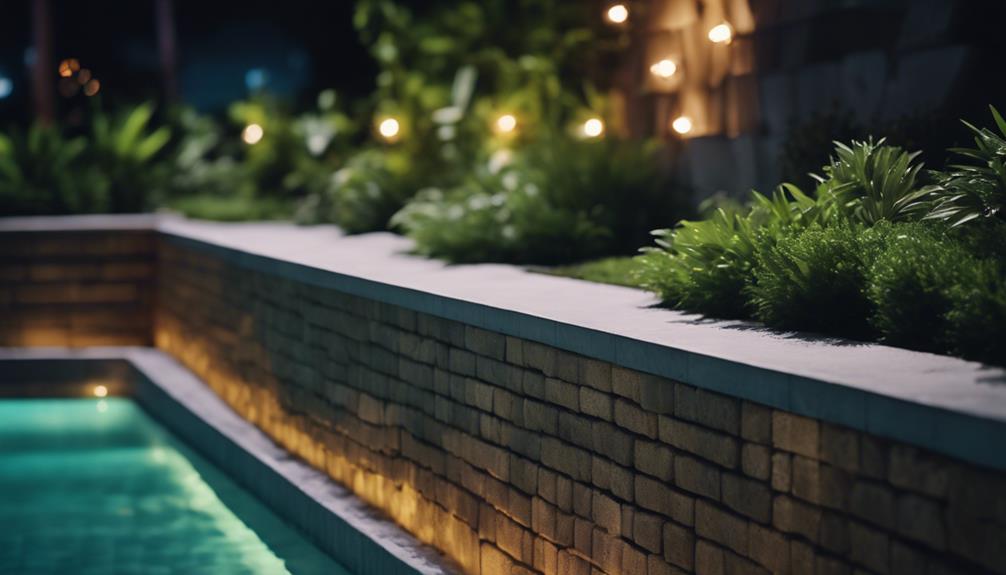
Examining retaining walls regularly is essential to guarantee their structural integrity and longevity. By conducting routine maintenance and inspections, you can make sure that your retaining walls remain functional and visually appealing for years to come. Here are some essential maintenance tips to keep in mind:
| Maintenance Tips for Retaining Walls | |
|---|---|
| Inspection | Regularly inspect the walls for signs of wear, erosion, and vegetation growth. |
| Backfill Soil | Ensure proper grading and compaction of backfill soil to prevent wall instability. |
| Protective Sealants | Reapply protective sealants every 1-3 years to safeguard the walls from weathering. |
| Professional Inspections | Schedule annual professional inspections to address any potential issues promptly. |
Following these maintenance tips will help you maintain the structural integrity of your retaining walls and prevent costly repairs in the future. Remember to replace any damaged sections promptly to avoid further deterioration.
Incorporating Lighting and Planters
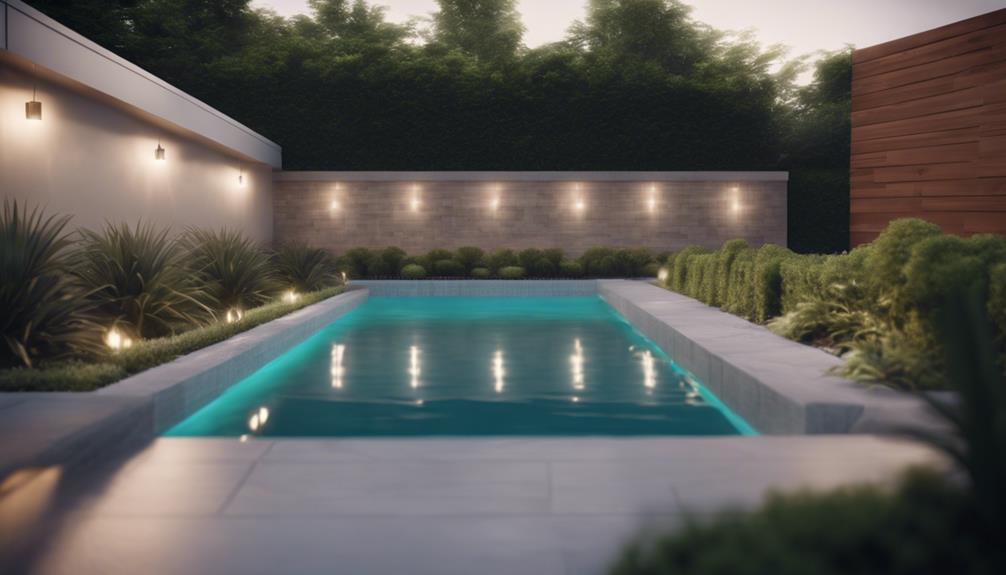
Enhancing your pool area with integrated LED lighting and planters in the retaining walls can elevate both the aesthetics and functionality of the space. The addition of these elements not only enhances the overall look of your pool area but also contributes to safety and ambiance, especially during nighttime.
Consider the following ideas to incorporate lighting and planters into your retaining walls:
- Create a mesmerizing nighttime ambiance: Install integrated LED lighting in the retaining walls to illuminate the pool area and create a magical atmosphere after sunset.
- Enhance safety: Strategically place lighting fixtures along the retaining walls to guarantee adequate visibility and prevent accidents in the dark.
- Embrace vertical gardening: Utilize planters integrated into the retaining walls to grow herbs, flowers, or small shrubs, adding a touch of greenery and color to the space.
- Highlight architectural features: Position lighting to showcase specific architectural elements of your retaining walls, creating a visually appealing focal point in your pool area.
Planning Your Pool Retaining Wall
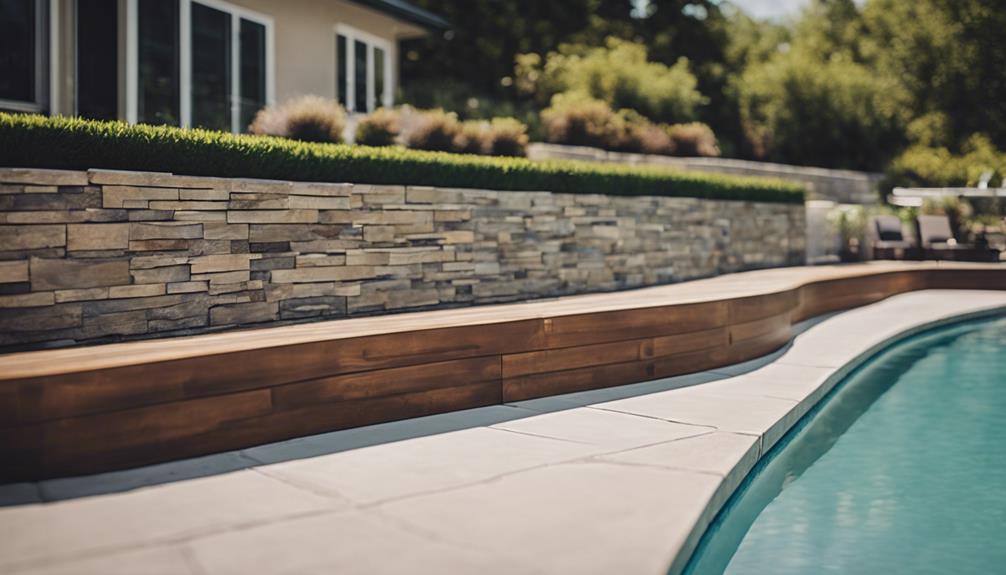
When planning your pool retaining wall, it's important to carefully measure the area, consider soil type, drainage needs, and layout for a successful project. Start by checking permits, especially for taller walls, and determine the desired height, typically ranging from 3 to 4 feet.
Adequate drainage solutions must be incorporated to prevent water buildup and structural issues. Proper planning is vital, including soil reinforcement and precise excavation before constructing the retaining wall.
Selecting suitable materials such as concrete blocks, natural stone, bricks, wood timbers, or poured concrete is significant based on factors like durability, cost, appearance, and installation complexity.
Following correct construction techniques, backfilling with gravel, and finishing with coping or decorative caps are key steps to guarantee a robust and visually appealing pool retaining wall that complements your outdoor design and enhances the landscape.
Take the time to plan meticulously to achieve a functional and aesthetically pleasing result.
Frequently Asked Questions
What Is the Cheapest Option for a Retaining Wall?
For a budget-friendly retaining wall, consider concrete blocks, wood timbers, DIY rock walls with local stones, or gabion walls filled with gravel. Opting for a lower wall height can help reduce costs while still providing support.
How Much Does It Cost to Build a Retaining Wall Around a Pool?
To build a retaining wall around your pool, costs can range from $3,500 to $10,000 based on materials, wall size, site conditions, and labor. Wood walls start around $15 per sq ft, while natural stone can be $30 or more.
Can a Retaining Wall Support a Pool?
Yes, a properly designed and constructed retaining wall can support a pool by preventing soil erosion and maintaining stability. It is essential to take into account factors like height, material, and drainage to guarantee the retaining wall effectively supports the pool.
How Do You Make a Retaining Wall Look Pretty?
To make a retaining wall look pretty, incorporate natural stone or wood for a rustic vibe. Add greenery with planters, cascading waterfalls for elegance, and unique mosaic designs for vibrancy. Finish with decorative caps, fencing, and lighting for a polished appearance.
How Can Retaining Walls Enhance the Aesthetics of a Swimming Pool Area?
Retaining walls can greatly enhance the aesthetics of a swimming pool area, creating a more visually appealing landscape. Incorporating unique swimming pool feature wall ideas, such as decorative stone or wood paneling, can add depth and texture to the space. These walls can also provide a cohesive and polished look to the overall design.
Conclusion
So remember, when designing your pool retaining wall, choose materials wisely, incorporate design elements for beauty, construct with longevity in mind, and maintain regularly.
Don't forget to add lighting and planters for extra flair.
With proper planning, your pool retaining wall can be both functional and beautiful.
Happy swimming!


